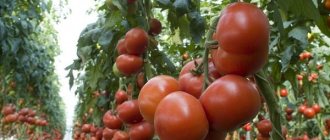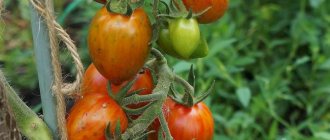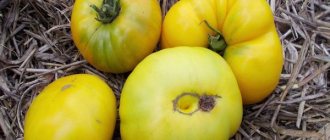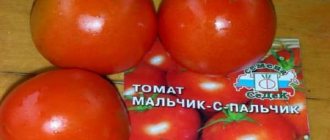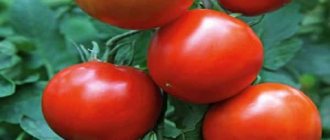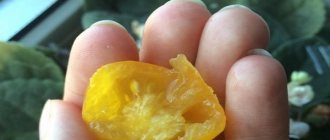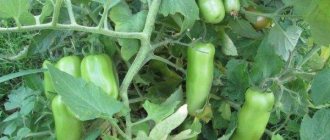Description of the tomato Worker and agricultural technology for growing the variety
Those who have grown the Worker tomato always have positive reviews of this variety. The variety is a Siberian selection, therefore suitable for central Russia, for the Ural and Far Eastern conditions.
General characteristics of the variety
The Worky tomato variety was created specifically for difficult climatic conditions. It tolerates both cold snap in mid-summer and daily temperature changes in August. The productivity of Worker remains stable even in cold rainy seasons.
The plant is of a determinate type; stem growth stops after the formation of several flower clusters. This allows the very last fruits to fill well.
Fruiting is extended, but tomatoes from each cluster ripen almost simultaneously, allowing gardeners to collect a large number of ripened tomatoes.
The Worker tomato is universal and can be grown in greenhouses, under film covers or in open ground. The bushes are of medium height, reaching 1.2 m, but they need staking to a support and pinching. To increase productivity, it is recommended to form a bush with 2-3 stems.
The characteristics and descriptions of the variety in catalogs specifically indicate the evenness of the tomatoes in the bunch.
Description of fruits:
- Up to 6 smooth and slightly elongated fruits are formed. Each weighs about 130 g.
- The skin is thick and durable.
- Even under unfavorable conditions, tomatoes practically do not crack. This increases the safety of the crop and additionally protects against damage by macrosporiosis.
- Tomatoes are perfectly transported when ripe.
The taste advantages are obvious: the sugar content of the fruit is 4.5-5%, tomatoes have a sweet taste with slight sourness and a pronounced aroma.
Hard worker is a universal tomato. The pulp of the fruit is fleshy and dense, which makes it possible to make sauces and pastes.
Small tomatoes look good in pickles and marinades, retain their shape well, and do not burst during heat treatment. Juice and puree are brightly colored, rich red.
Fleshy tomatoes with very small seed chambers are suitable for drying.
Obtaining an early harvest (100-110 days after sowing) allows you to use Worker tomatoes for preparing summer salads, snacks, sandwiches; the thick, durable skin can be easily removed.
To increase the yield, fertilize with mineral fertilizers, adding nitrogen mixtures (nitrophoska, nitroammophoska) 1 week after planting, and after the start of flowering - potassium-phosphorus. Fresh organic fertilizers cannot be fed.
After the bushes transplanted to a permanent place begin to grow, you need to shape them. With a single-stem scheme, the stepsons are removed constantly, starting from the axils of the lowest leaves.
Formation into 2-3 stems implies 1-2 stepsons on the lower tier and removal of all subsequent ones on the main stem. Tie it to a support under the first hand, and then continue tying it as it grows.
Features of agricultural technology
Ass Worker is grown using the seedling method.
- Seeds are germinated for seedlings approximately 2 months before planting the plants in the ground. For seedlings, containers with fertile soil are used, usually a mixture of garden soil with humus or peat. To maintain heat and humidity, the plantings are covered with film.
- When the first loops of the plant hatch, the seedlings need good lighting.
- After the first pair of true leaves appear, the ass is dived, moving into larger containers. To prevent the plants from stretching out as they begin to rise, but from forming a strong trunk, it is recommended to periodically harden the seedlings, lowering the room temperature.
Worker eggs grow well both in open beds and in greenhouses. Seedlings are planted in public soil after spring frosts have passed, and in greenhouses in early May. Let the plants stop their upward growth on their own; to improve their productivity, what can you do by pinching them, removing excess shoots from the leaf axils. Typically, bushes are formed, leaving each with 2-3 full-fledged stems from the stepsons of the lower tier. The large number of fruits makes it necessary to stake the plants. For this purpose, wallpaper is used, and in greenhouses - elements of its design. The first garter is carried out under the lower brush and then as the bush grows.
Mineral complex fertility granules and nitrogen-containing mixtures are well suited for feeding tomatoes (you can use nitrophoska, nitroammophoska). After the beginning of the flowering phase, potassium-phosphorus fertilizers are switched to
It is important to remember that tomatoes of this variety do not tolerate fresh organic fertilizers. During periods of no rainfall, butts require watering at least once a week.
Mulching with hay or sawdust has a great effect on the growth of bushes, especially in regions with a hot climate - mulch prevents the soil from drying out and is an additional organic fertilizer. Other plantation care measures include loosening the soil and regular weed control. The category requires protection from major nightshade diseases. Plants are also supposed to be treated against pests.
Tomato Stesha - description and characteristics of the variety
The Stesha F1 variety compares favorably with many varieties of tomatoes. Many experienced gardeners give it their preference, noting the very high level of productivity, unusual shape of the fruit and bright color. This type of tomato appeals to both children and adults, and is used to prepare a variety of dishes - tomato soups, sauces, Italian pasta, and is also prepared for the winter in its entirety.
Characteristics of the variety
Experts classify the Stesha tomato variety as an indeterminate, high-yielding, early-ripening hybrid. From the first shoots to the full ripening of the crop, on average, 100 days pass, provided that the plant develops correctly and all care rules are followed. Summer residents collect up to 22 kg of ripe fruits from 1 square meter.
The bushes reach 210 cm in height and need to be tied to a support. This hybrid is characterized by a small amount of tops and a simple inflorescence shape, which is laid above the 7-9 leaves.
The plant is distinguished by its strong immunity, which is confirmed by reviews from gardeners growing this variety. Breeders claim resistance to a number of common diseases:
- Late blight.
- Alternaria.
- Viral tobacco mosaic.
Fruit characteristics
Stesha tomato fruits have a number of features, including:
- Unusual berry shape. The berries have a heart-shaped, cylindrical, plum-shaped shape.
- Color. The ripened fruits of this variety have an unusual color. They can be colored in different shades of yellow - from amber yellow to rich golden orange.
- Weight and size. Each tomato can weigh 120-150 g, which indicates the average size of the berries.
- Smooth and dense surface of tomatoes.
- Juicy pulp.
- High yield.
- Excellent taste. Stesha tomatoes contain a large amount of sugar, which causes a sweet taste.
Features of growing a plant
Agronomists note that tomatoes of the Stesha variety can be grown in any conditions. The plant is capable of producing a good harvest and growing actively both in an indoor greenhouse and in open beds.
- Treatment with a disinfectant solution.
After purchasing, the seeds should be soaked in potassium permanganate. In this case, the solution should be weak. - Use of biostimulants.
To achieve the maximum percentage of germination, it is recommended to use biostimulants. Seed material is soaked in Kornevin or Epin. - Soil selection.
The soil for germination should have a loose structure and a large number of useful elements. You can use either soil mixture purchased in a store or nutrient soil mixed yourself. - Planting seeds.
Seed material is planted in containers with soil mixture to a depth not exceeding 3 cm. - Greenhouse conditions.
To create a microclimate favorable for seed germination, it is recommended to cover the containers with film or glass. - Picking.
Young shoots of tomatoes peak after the appearance of 2 true leaves. - Feeding.
During the process of plant growth and formation, mineral fertilizers are introduced into the soil. Over the entire period, the bushes are fertilized 3 times. - Hardening.
It is recommended to start hardening the seedlings a week before transplanting to a permanent place of growth. To do this, containers with young plants are taken outside every day. The time spent outdoors should increase gradually.
Planting in open ground is carried out after stabilization of the temperature regime. At this point, the plant should have reached 65 days of age. Tomatoes are planted in the ground in the evening using the transshipment method. Agronomists recommend placing young plants in such a way that no more than 4 bushes grow per 1 square meter. This guarantees the correct development of the root system and the absence of harmful effects of plants on each other.
To achieve proper formation and active growth of the plant, you must follow simple rules of care:
- Regular watering with warm water.
- Introduction of fertilizers during the growing season.
- Removing weeds.
- Loosening the soil.
- Timely harvesting.
The Stesha tomato is an unpretentious variety and is able to please the summer resident with a good harvest, thanks to which its popularity is growing every year.
Tall tomatoes for the greenhouse
I definitely plant the listed varieties, but there are also some that I just liked, and I periodically grow them in the greenhouse, but I have not become a fan of them. Of the indeterminates, I like the raceme varieties the most. Again, this is primarily because they look beautiful on the bush. There are only three varieties, and each has a special reason to grow it.
“Intuition F1” is a mid-season hybrid, but I would classify it as a late-season hybrid. Not only does it reach harvest ripeness only by mid-August, but biological maturity also comes quite late. Some specimens of these tomatoes ripen even until the end of October. But, on the other hand, this is convenient because as a result, we have our own fresh tomatoes at home for a very long time. That's why I sow it in February.
Rice. 12. Photo from the end of July, but the fruits have not yet begun to ripen.
But “Intuition F1” is very easy. This hybrid is great for freezing for future use. In winter, I make pizza and frittata with them, as they do not defrost like porridge, but retain their meatiness well when cut.
Rice. 13. The fruits are all smooth and beautiful.
Rice. 14. In this form, I send “Intuition F1” to deep freeze.
“Scarlet Candles” is a cluster variety, mid-season. They don’t have a special taste, but what a shape! Looks impressive in preparations with cucumbers. However, this is why I grow them. It’s nice to admire such a jar later in the winter.
Rice. 15. The length of “Scarlet Candles” is almost like pickling cucumbers.
Rice. 16. “Scarlet candles” look neat, they all have a characteristic “spout”.
“De Barao” is quite late-ripening; I sow it earlier than the bulk of tomatoes. I really like it in preparations, it does not crack and is very tasty, both fresh and pickled.
Rice. 17. "De Barao" is resistant to disease. I always plant it on the north side, tying it above the entrance to the greenhouse, because it is very tall, and the upper tier ripens even in the last ten days of August, despite the first cold nights.
Rice. 18. The fruits are beautiful, all as one.
I have tried a great variety of salad varieties, I still want to find the most delicious one. Of the unusually colored tomatoes, I really like the taste of Malachite Box and Black Prince . Both are tall and require pinching, gartering, and formation into 1-2 stems, but the effort is worth it, the fruits are magnificent. “Black Prince” is dark burgundy when fully ripe.
Rice. 19. “Malachite box” in biological maturity – green.
Description of the early ripening tomato Northern Express F1 and growing the hybrid
Tomato Northern Express F1 is a modern early-ripening hybrid created specifically for farms in the northern regions. These tomatoes are recommended for risky farming areas: Siberia, the Urals and the Far East. But Northern Express can also be grown in the Moscow region or the warm southern regions of Russia.
Characteristics of the variety
The hybrid is determinate, with spontaneous topping after the formation of 5-6 clusters. The overall dimensions of the bush are 1.2-1.5 m. The plant requires obligatory garter to a support. Due to the active formation of side shoots, it also requires pinching.
The hybrid tomato variety Northern Express can be grown in greenhouses and in open ground. The plant is resistant to temperature changes and produces consistently high yields even in cool rainy seasons. The hybrid is resistant to most fungal diseases: the bushes are not affected by late blight, cladosporiosis, and fusarium. The plant is immune to the tobacco mosaic virus.
The hybrid is early ripening; it takes about 100 days from germination to commercial production. Fruit ripening is consistent. Northern Express is suitable for both personal farms and small farm enterprises specializing in the production of early vegetables. The average yield of the Northern Express tomato is about 4 kg of fruit from 1 bush.
Advantages of fruits
The characteristics and description of the variety in the catalogs particularly highlight the evenness of the tomatoes on the plant. The average weight ranges from 120-150 g, without significant deviations. The shape of the fruit is round, slightly flattened at the poles, without ribbing.
The skin of the fruit is colored intense red in the phase of full ripeness. Tomatoes do not have a green spot on the stalk, the color is uniform. The fruit shell is highly durable. The fruits can be transported over long distances without loss; they are stored ripe for a long time and ripen easily if collected at milky ripeness.
The pulp is evenly colored. The color is pinkish-red, the seed chambers do not have a green or yellow tint, there is no light shaft in the center and a pale zone at the stalk. The consistency is dense, but quite juicy.
Reviews from gardeners characterize the taste qualities as high. The average rating on a 5-point scale is 4.5. The taste of the fruits of the Northern Express variety is sweet and sour, classic. The tomato aroma is well expressed.
Small, neatly shaped tomatoes are well placed in jars for whole-fruit canning. The thick skin does not crack during heat treatment, and the appearance of the marinade is always perfect. Northern Express tomatoes can be juiced and used for tomato sauces or concentrated paste.
How tomatoes are grown
In Russian conditions, only seedlings of tomatoes are grown. The seeds of the early ripening Northern Express variety are sown in mid-to-late March. The soil for sowing must be well saturated with a hot, dark pink solution of potassium permanganate. This will enrich the soil with potassium salts and destroy the pathogens of root rot, which often affects tomato seedlings. Scatter the seeds over the surface of the moist soil, cover with a layer of dry soil 0.3-0.5 cm thick. Cover the boxes with glass or film.
At a temperature of +25°C, seedlings will appear 4-5 days after sowing. Grow seedlings without shelter at room temperature until 2-3 true leaves form. Plant the plants according to a 7x7 cm pattern. Further care of the seedlings comes down to timely watering.
After planting in a permanent place, the tomatoes need to be fed: 1 week after transplantation, nitrogen mixtures are added, which ensure the growth of the green mass of the plant, and after the formation of 1 inflorescence, phosphorus-potassium fertilizers are added
The dosage of fertilizers may vary, so it is advisable to pay attention to the recommendations of the drug manufacturer
Description
The plant is indeterminate, tall, 170 - 190 cm high. The stem is strong, the foliage is moderate. The leaves are dark green, medium in size, slightly more than 30 cm long, of the usual type, the dissection of the lobes is weak, the surface is slightly wrinkled. Inflorescence of complex type. The first fruit cluster is formed after the 9th leaf, the subsequent ones - after 3-4 leaves. There are 5 clusters on the main stem, each with 6-8 fruits. Pedicel with articulation.
The fruits are beautifully heart-shaped, slightly ribbed, of medium density. An unripe tomato is light green with a dark spot at the stalk. When ripe it turns crimson. The skin is not thick, durable. The pulp is fleshy, juicy, tender. The number of seed nests is more than 6 pieces. The taste is good. The average weight of a tomato is 204 grams. Individual specimens can reach 600 - 700 grams. 100 g of pulp contains: 6.8 - 6.9% dry matter, 4.8 - 5.9% sugars, 0.30 - 0.40% acids, 15.3 - 23.5 mg of ascorbic acid.
Diseases and pests
"Glacier" has a very high resistance to fungal diseases. In rare cases, it may be affected by root rot. This disease is combated by loosening the soil, reducing watering and mulching.
You should also be wary of diseases associated with improper care. To avoid these troubles, you must follow the watering schedule and regularly loosen the soil. Ventilation measures will also be effective if the plant is in a greenhouse.
If you are interested in what diseases most often threaten tomato plantings, read all about: Alternaria, Fusarium, Verticillium, late blight and measures to protect against it.
Among the harmful insects it can be affected by melon aphids and thrips, the drug “Zubr” is successfully used against them. In the southern regions, the Colorado potato beetle can harm this species; Prestige is successfully used against it.
It is also susceptible to fall armyworm in open ground. This pest is combated by removing weeds on which it can actively develop. They also use the “Bison” product.
We also bring to your attention articles about how and why fungicides and insecticides are used in the garden.
Why are growth stimulants needed and are there varieties that are completely free from late blight?
As follows from the brief review, this is a fairly easy-to-care variety. Even a gardener without experience can cope with its cultivation. Good luck to you and a rich harvest.
Below you will find links to tomatoes with different ripening periods:
| Early ripening | Mid-late | Mid-early |
| Raspberry Viscount | Yellow banana | Pink Bush F1 |
| The Tsar Bell | Titanium | Flamingo |
| Kate | Slot F1 | Openwork |
| Valentina | Honey fireworks | Cio Cio San |
| Cranberries in sugar | Miracle of the market | Supermodel |
| Fatima | gold fish | Budenovka |
| Verlioka | De Barao black | Major F1 |
Parsley gardener
This variety is widely loved by many gardeners due to its disease resistance, unpretentiousness and high yield.
Seedlings are planted both in open ground and in greenhouses. The plant is low-growing, reaches a height of up to 60 cm. The Parsley variety does not form stepsons, which greatly facilitates caring for the plant during the period of growth and ripening of fruits.
Description of the variety
The fruits have a rich bright red color. The variety got its name due to its great similarity with Parsley's cap.
Tomatoes have fleshy, juicy, sweet flesh. The weight of one tomato reaches 200 grams.
Ripe fruits are used in canning, making juices, ketchup and sauces.
Advantages of Parsley tomato:
- Does not require stepsoning.
- Long fruiting period.
- Parsley is drought and disease resistant.
Tomato Ulisse F1 - description and characteristics of the variety
Explication of the form
The plant is classified as determinant. First of all, this tomato is distinguished by its elongated oblong shape, reminiscent of a cap. A ripe tomato has a red color with an orange tint. The average fruit weighs 110 grams. Copra is dense and contains many vitamins and nutrients.
This variety is extremely profitable to grow in industrial conditions, since it is stored without memory for a long time - more than 2 months. But only if the correct maintenance contract is followed: the place must be sufficiently cool and dark, spoiled eggs must be removed in order to preserve the entire harvest. It handles transportation wonderfully, even over long distances.
Ulisse has a powerful vine with infinitely large foliage, this allows the plant to avoid sunburn. Strong bushes are prone to overgrowth, which is why mandatory pinching is required. A huge number of tomatoes usually ripen on one bush, often up to 15 pieces. They grow together, the bushes must be tied to a support, otherwise the branches may break before the harvest is fully ripened.
This hybrid variety has an early ripening period, and already 100 days after the germination period the first fruits can be picked. And after planting the seedlings, 65–70 days pass before the fruits fully ripen. Ulisse's flowering and upbringing is carpal. Can be grown in greenhouse conditions and in open beds.
The variety has high taste qualities. Candy-like and with a pronounced tomato aroma, Ulisse is used not only fresh, but also made into juices and marinades. It is very convenient for salting, canning and pickling.
Picture for growing
You can grow the plant from seeds by direct sowing, later the vegetables will ripen within 100 – 110 days. And with the help of seedlings, the moment of ripening will be much shorter - up to 77 days.
I plant seeds in (types of obtaining seedlings in March. When choosing a hybrid variety Ulisse, you need to get high-quality seeds in a package so that it contains all the information about the manufacturer, with the name of the crop and variety, and expiration date.
If you still have your own seeds, you might want to check them for germination, as they sometimes turn out to be immature. For this purpose, the seeds are placed on a paper napkin, one napkin is placed on top, and then everything is wetted. Over the course of 3–7 days, you should observe whether sprouts have appeared, and the napkins should be wet every minute. This is a very proven method and helps determine the quality of the seeds. (otherwise the seeds are more than 5 years old, they may lose such a necessary aspect as germination.
Before planting, the seeds need to be strengthened, for which they are warmed up and disinfected. Experienced gardeners advise growing the hybrid variety Ulisse in juice containers. Tetrapack is, without a doubt, convenient, but when planted in this type of cardboard packaging, plants grow miraculously slowly. The fact is that their inner side is coated with a substance that has an unflattering effect on the soil, since it is aimed at preventing food spoilage. It is better to use peat pots, but plastic cups for sour cream and yoghurt will do.
If the container contains a fairly small amount of soil taken from the garden, then, once in the open ground, it will be easier for the plants to adapt to new conditions. If you immediately add a small amount of ash here, the soil will be enriched with useful microelements, primarily potassium and phosphorus, and the protective properties against fungal diseases will increase. It is also advisable to supplement the soil with manure and peat as fertilizer.
Until the first shoots appear, you should cover the containers with film and make sure that the room temperature does not fall below +23 degrees. Flooding is carried out only with warm water. If the room has very dry air, it will be more difficult for plants to germinate. It is necessary to provide the plants with a large amount of light; many use an additional special lamp for this, which must be directed so that the light also falls on the stems. This is an arrogance, since due to the dense foliage cover, the bushes can only multiply upward, which is why part of the harvest may be lost.
When the super-elite is lowered directly into the ground, the following scheme is observed - 50 by 40 centimeters. Loam must be fertile.
The bushes of this variety, if they are not allowed to branch, are very compact, therefore up to 7-9 plants can be planted on one square meter. Seedlings are planted only after the air temperature has not stabilized and will not drop below +18 degrees.
The pitfall for the variety is late blight and the causative agent of the yellow leaf curl virus.
Detailed information about the plant
The variety was bred in Siberia, but has adapted well to the southern regions of Russia.
Moreover, if in the northern regions tomato is grown only in a greenhouse, then in the south it grows in the open air without any problems. Batyanya is an early-ripening tomato; the ripening time is 94-100 days. The specificity of the variety is that the fruiting period lasts until autumn. This quality makes the tomato profitable when grown in garden plots.
The variety is indeterminate, that is, the growth of its stem is not limited to a certain size. The height of the bushes is 1.5-1.7 meters; in a greenhouse the plant can grow up to two meters. The leaves are large in size and rich green in color.
Tomato Batyanya is considered a high-yielding variety. Under appropriate conditions, you can pick up to 6 kg of tomatoes from each bush, this is a very good indicator.
Diseases and their prevention
The Pink Leader variety has good immunity against diseases inherent in tomatoes, but this does not exclude the possibility of infection with late blight, gray rot, and brown spot.
To avoid crop losses and save money, it is better to resort to effective preventive measures, which include:
- Maintaining crop rotation. Do not plant tomato seedlings in their previous location earlier than five years later. And also plant tomatoes away from potato plantings, which are the primary carrier of the infection.
- Using only high-quality planting material. Before sowing, complete all necessary measures to prepare the seeds for planting.
- Compliance with the rules for soil preparation and planting according to all standards, which is considered a guarantee of successful plant growth.
- Creating comfortable conditions for the normal development of tomatoes.
- Proper application of fertilizers. Do not use manure and fresh compost for vegetables, only humus and well-rotted compost.
The main thing is to notice the first symptoms of plant infection in time, quickly recognize the disease and properly improve the health of the tomato bed.
Variety Chibis
Chibis tomatoes are a mid-season, high-yielding hybrid. From the moment of emergence of seedlings to harvesting, 110 days pass. The hybrid is grown both in open ground and in greenhouses.
The bush is compact, reaching up to 70 cm in height. Planting pattern 40×50.
The fruits are oblong, have a bright red color, fleshy and juicy pulp, weighing up to 60 grams. With good care, you can collect up to 3 kilograms of fruit from a bush.
Tomato care:
- Regular watering.
- Fertilizing with mineral fertilizers.
- Weeding and timely loosening of the soil.
Hybrid Chibis is used for salads, whole-fruit canning and barrel pickling.
Description of the tomato variety Worker, features of cultivation and care
The Worker tomato, bred by Siberian breeders, is suitable for growing both in the Far East, the Urals, and in the climate of the middle zone. Tomatoes are universally used and yield is good. It withstands temperature changes and rainy weather, without reducing the product indicators.
Description of the variety
The characteristics and description of the variety say that the bush of tomatoes of the Rabotyaga variety is determinant. As soon as a pair of brushes with peduncles is formed, the growth of the stem stops. Thanks to this, the fruits are poured evenly. Tomatoes do not ripen at the same time, which ensures a long harvest of fresh tomatoes. With the onset of persistent cold weather, unripe fruits are collected and ripening takes place indoors. Product quality and taste do not suffer.
Tomato is successfully cultivated both in greenhouses and in open ground. The average height of the bush is 1.2 meters. Gartering and pinching are required. Those who have planted the Worker variety tomato on their plot confidently advise molding the bush into 2-3 stems. They claim this helps increase yields.
Description of fruits:
- The fruits of the Worker variety are slightly elongated, even, and of the same size.
- 6 tomatoes weighing up to 130 grams are formed on a brush.
- Tomatoes are resistant to cracking and have thick skin.
The Worker variety tolerates transportation well over long distances, even when ripe, and is well stored without losing its marketable qualities. Suitable for growing on an industrial scale.
Advantages and disadvantages
Reviews about the Hardy variety are tempting to have this tomato on your property. Sweet fruits, the sugar content of which is 4.5–5%, have a slight sourness and a strong aroma. The small number of seeds and dense pulp indicate a very high quality of tomatoes. The Worker variety is suitable not only for fresh consumption, but also for all types of processing, whole-fruit canning, and is used for preparing culinary masterpieces. The harvested crop can be dried and heat treated.
According to reviews from practicing gardeners, no significant shortcomings were noticed. True, it is recommended to carry out preventive treatments against major diseases. Despite the fact that Worker has excellent immunity and is resistant to damage by pests, sometimes plantings still suffer from their adverse effects.
Features of cultivation
Tomato Worker is not capricious in care and cultivation. An experienced summer resident claims that she planted the seedlings 2 months before planting them in the beds. As soon as the threat of night spring frosts has passed, you can move the plants into open ground.
In order to increase productivity, the Worker variety is fed with mineral complex fertilizers, as well as nitrogen mixtures. It is strictly prohibited to introduce fresh organic matter. In the absence of precipitation, plants need watering, which is carried out once a week. Periodically loosen the soil, weed and remove weeds. In hot climates, it is advisable to mulch the soil.
Mown and dried grass can serve as mulch. This will prevent the soil from drying out and premature weathering of moisture. Subsequently, the mulch will make an excellent organic fertilizer.
The Worker variety is a worthy choice for both summer residents and professional farmers. To obtain a high and high-quality harvest, you need to put in a minimum of effort, and the taste of the harvested fruits is simply magnificent.
Advantages and disadvantages
Varieties of large-fruited tomatoes are an ideal choice for both experienced and novice gardeners. The name “large tomatoes” means that the fruit weighs 300 grams or more. Gardeners manage to grow individual fruits up to 1.5 kg.
And the world's largest tomato, weighing 3.8 kg (8.41 lb), was grown by a farmer from Minnesota (USA). This figure was recorded in the Guinness Book of Records, and Dan McCoy received a $1,000 prize. Here's another incentive for you to grow these varieties of tomatoes - and maybe your harvest will be even larger!
Large-fruited tomatoes have many advantages:
- they have good taste;
- the harvest can be obtained throughout the gardening season, since among them there are very early varieties, late ones, with extended fruiting;
- large tomatoes are in high commercial demand in the market and are profitable for sale;
- they are most suitable for making juice and other preparations;
- they are characterized by high productivity;
- allow rational use of space in beds and greenhouses.
Also, it is worth noting that varieties of large sweet tomatoes are distinguished by the greatest variety in color and shape of the fruit. You can find red, pink, yellow, white, chocolate, multi-colored, green fruits. The shape can be round, flat, elongated, plum-shaped and pepper-shaped, ribbed.
With all the advantages, large-fruited varieties and hybrids of tomatoes also have some disadvantages, or rather, they should be called features:
- large fruits are not suitable for canning as a whole (they do not fit into the neck of the jar), and when cut into pieces they fall apart due to the delicate consistency of the pulp;
- they have thinner and more vulnerable skin, so transportation and storage require special conditions;
- a lack of moisture during the growing process reduces the yield and size of the fruit, and an excess leads to cracking and reduced quality of tomatoes;
- Due to the high yield and size of the fruits, plants require fertile soil with nutrients.
But this is completely covered by the taste and other advantages that they possess. We bring to your attention a review of them with photos and descriptions below.
Farmer reviews
Let's consider the reviews of summer residents who have already grown the Buyan tomato.
Margarita: “I bought a bag because I had already heard that this variety is “for the lazy.” The seeds sprouted with a bang. I didn’t particularly choose the place for the seedlings: the only free space was in the shade of the tree. Due to the fact that there was not enough light for them, the tomatoes appeared later than other varieties that I planted on the site. But I collected fruits regularly. The bush is low, shaggy, it does not need to be trimmed or tied up. Just a beauty, not a plant!”
Alina: “We are beginners as gardeners, but Buyan’s seedlings did not disappoint: we took them to the dacha without any hassle, and they were still lush, fresh, nothing wilted or broke. Just as they were planted in the ground, they grew - no worries with them, no hassle! The tomatoes themselves are oval, smooth, a sight for sore eyes. I made salads from them all summer. True, the skins on them often burst, but since I immediately processed them in the kitchen, it was okay, not fatal.”
Igor: “It’s a good variety, it didn’t disappoint. For the sake of experiment, I planted them in the greenhouse with other tomatoes. What was surprising was that the seedlings, unlike other varieties, did not stretch. I didn't bother with it much. Planted in April, starting in June, the bushes bore fruit all summer. The harvest was abundant; every day I left the greenhouse with two full buckets of fruit. I’ll definitely plant it next year.”
Care
The tall variety Purple Jasper requires special care. The main thing in a successful harvest of tall tomatoes is the garter of the plant stem. There are several options for this: garter to a trellis, garter to high pegs.
Warm watering, ventilation of the greenhouse, pruning of stepsons are the key to high yields. For better ventilation of the plant, about once every seven days, remove 1 leaf from the bottom of the stem.
To improve plant growth and increase fruit size, bushes can also be fed with fertilizers. If you want to stop the growth of the bush, you need to trim its top.
To feed vegetables, use natural fertilizers: bird droppings, diluted mullein.
Growing seedlings
Tomato seeds are planted 60 days before planting the bushes in the garden. After the third leaf appears, the plants are planted, that is, planted in separate containers. Usually this procedure is performed on the tenth day after the first shoots appear.
Gardeners most often use disposable plastic cups.
Seedlings should be cared for daily. It consists of moistening the soil and ensuring a sufficient level of illumination. Water the bushes at the root using a pipette or syringe.
At a temperature of 15-20 degrees, seedlings are placed on the balcony. Seedlings need to be fertilized 2-3 weeks after green shoots appear. Organic solutions are used - manure or grass.
After flower clusters appear on the seedlings, after a couple of weeks they are planted in the garden bed. At this time, plants should have dense stems, a developed root system, large leaves and noticeable buds.
It is best to plant seedlings in the ground in sunless, cool weather, when there is no wind.
Our technology for growing tomatoes of different varieties is as follows. On our plot we allocate 6 long rows for tomatoes (including closed soil). On three of them, representatives of the best varieties of tomatoes, proven over the years, are grown (there are also tomatoes to choose from), guaranteeing a harvest according to the declared characteristics (regardless of the “delights” of the weather), and the other three are planted with new varieties, which are “considered” this way and that in during the above time. That seems to be it.
PS To make life easier for readers and reduce the time it takes to absorb the article, instead of determining the yield of vegetables in kg per 1 square meter, it will be written below - kg “per square”.
And now I am announcing the number of tomatoes tested in growing, presented below for your viewing, which can still be called the best - 60 varieties.
PS The results were recorded in an area that: with a good warm season, corresponds to the Central Black Earth region (region), and with a bad warm season, corresponds to the North-Western region. Naturally, this range of latitudes in which the above regions are located definitely includes Siberia, the Moscow region, the Middle Zone, the Urals, the Far East, and then figure out for yourself where exactly the paths lead to your site.
Opinions
Tomato Batyanya collects positive reviews about itself. Having planted a plant once, gardeners become fans of the variety. This is due to the excellent agrotechnical characteristics of this crop.
Gardeners note the early ripening of fruits. The Batyanya tomato itself (the characteristics and description of the variety are given above) enchants with its amazing qualities. Gardeners do not experience disappointment in the process of cultivating tomatoes. There is no special technique for growing these tomatoes; the whole process of agricultural technology is the same as for other tomato crops.
The Batyanya tomato, reviews of the fruits of which form a separate topic, amazes gardeners with the amazing taste of the fruit. As gardeners say, it is a pity to preserve these fruits, they are so tasty fresh.
Another advantage of the Batyanya tomato noted by all owners is productivity. The bush is literally strewn with large attractive fruits. And the need for supports does not frighten experienced gardeners at all.
The long fruiting time allows you to collect a lot of tomatoes and use them for various purposes - for salads, winter canning, making sauces.
